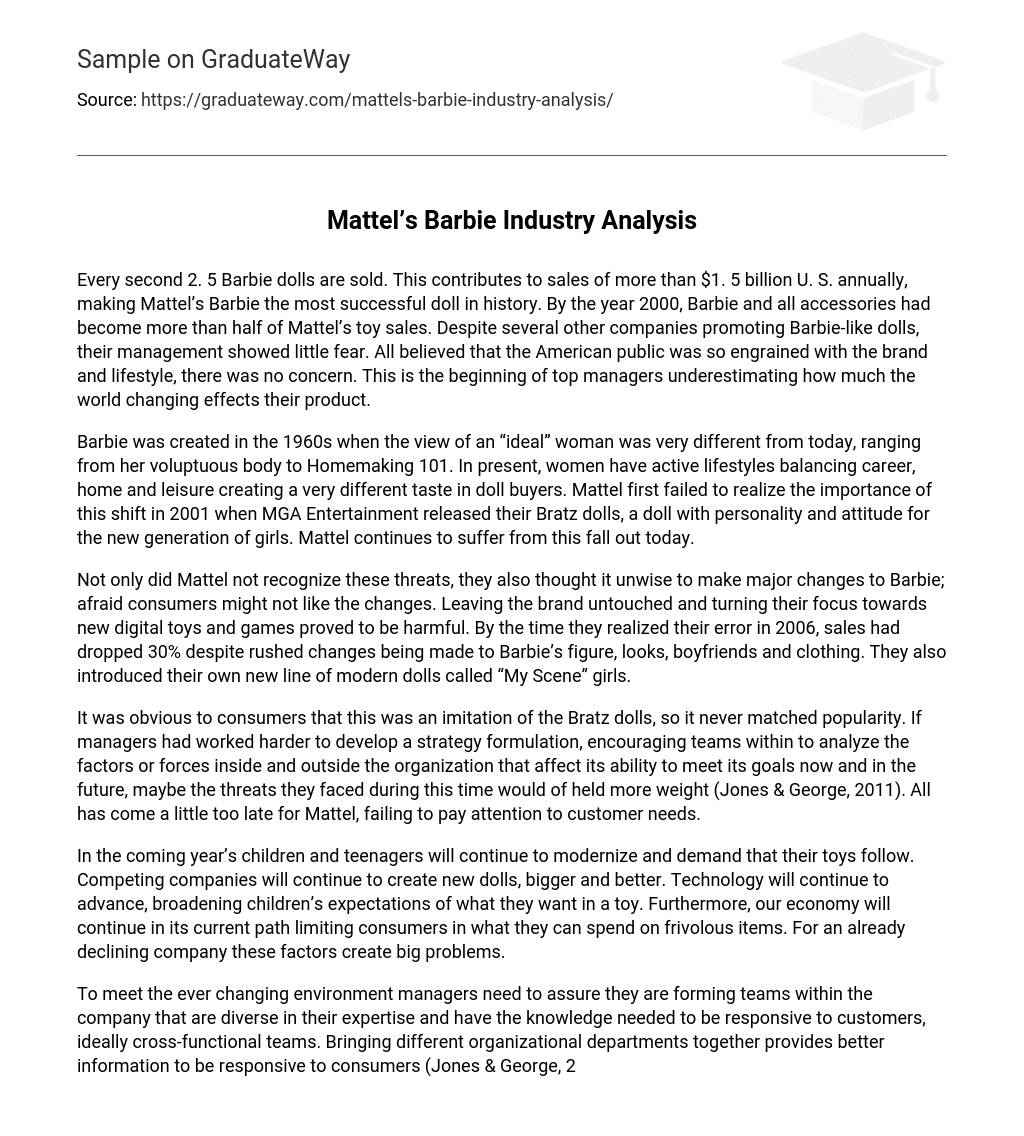Every second 2. 5 Barbie dolls are sold. This contributes to sales of more than $1. 5 billion U. S. annually, making Mattel’s Barbie the most successful doll in history. By the year 2000, Barbie and all accessories had become more than half of Mattel’s toy sales. Despite several other companies promoting Barbie-like dolls, their management showed little fear. All believed that the American public was so engrained with the brand and lifestyle, there was no concern. This is the beginning of top managers underestimating how much the world changing effects their product.
Barbie was created in the 1960s when the view of an “ideal” woman was very different from today, ranging from her voluptuous body to Homemaking 101. In present, women have active lifestyles balancing career, home and leisure creating a very different taste in doll buyers. Mattel first failed to realize the importance of this shift in 2001 when MGA Entertainment released their Bratz dolls, a doll with personality and attitude for the new generation of girls. Mattel continues to suffer from this fall out today.
Not only did Mattel not recognize these threats, they also thought it unwise to make major changes to Barbie; afraid consumers might not like the changes. Leaving the brand untouched and turning their focus towards new digital toys and games proved to be harmful. By the time they realized their error in 2006, sales had dropped 30% despite rushed changes being made to Barbie’s figure, looks, boyfriends and clothing. They also introduced their own new line of modern dolls called “My Scene” girls.
It was obvious to consumers that this was an imitation of the Bratz dolls, so it never matched popularity. If managers had worked harder to develop a strategy formulation, encouraging teams within to analyze the factors or forces inside and outside the organization that affect its ability to meet its goals now and in the future, maybe the threats they faced during this time would of held more weight (Jones & George, 2011). All has come a little too late for Mattel, failing to pay attention to customer needs.
In the coming year’s children and teenagers will continue to modernize and demand that their toys follow. Competing companies will continue to create new dolls, bigger and better. Technology will continue to advance, broadening children’s expectations of what they want in a toy. Furthermore, our economy will continue in its current path limiting consumers in what they can spend on frivolous items. For an already declining company these factors create big problems.
To meet the ever changing environment managers need to assure they are forming teams within the company that are diverse in their expertise and have the knowledge needed to be responsive to customers, ideally cross-functional teams. Bringing different organizational departments together provides better information to be responsive to consumers (Jones & George, 2011). Toy designing and selling is an ever changing environment. Mattel chose not to give important factors the required attention to remain at dominate sales levels.
The Barbie brand continues to introduce new and improved products, but not providing the percentages it once brought to the Mattel Company. A copyright lawsuit filed against MGA Entertainment in 2008 rewarded the company $100 million in damages and forced MGA to stop selling the Bratz dolls. This was a positive step, eliminating its major competitor, but Mattel’s stocks continue to decline. They have learned that in this industry, it is important to continually look at marketing strategy and anticipate change while building relationships with new and existing customers through consumer demand (Jones & George, 2011).
Mattel has managed to make some positive changes in the Barbie brand by creating more African-American, Hispanic and Asian Barbie dolls. Themed dolls were introduced to change with the times — from stewardess, fashion model, nurse, teacher, veterinarian and astronaut. If this company continues to walk in the path of consumer needs and positive change, it has the potential to build the Barbie brand back into its star product.





